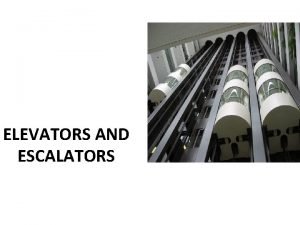Means of Vertical Circulation Elevators traction verse hydraulic




- Slides: 4

Means of Vertical Circulation: Elevators traction verse hydraulic types, sizes, speeds and finishes, escalators. Traction Elevators Hydraulic Elevators By: Andres Tovar

The Functions of the hydraulic elevators as well as its respective advantages • A Hydraulic elevator differs from a Traction elevator in that it has a single plunger jack installed directly under the elevator car. • Significantly lower initial expenses in equipment and in its maintenance. • Take up a substantial lower amount of space in a building. (allow for efficient space usage) • An overhead machine room is not required for hydraulic elevators. • Hydraulic elevators don’t enforce vertical loads on the building structure meaning that the columns can be significantly reduced in the shaftway area. • Hydraulic elevators have only one mechanical connection between the machine room and the shaftway referred to as a pipe and conduit. This allows for more flexibility in the machine room. • More effective for high load capacity requirements. The hydraulic elevator allows for much greater lifting forces with higher mechanical efficiency and with a lower cost.

The Functions of the hydraulic elevators as well as its disadvantages • The elevator performance becomes unpredictable as the oil in the system varies in temperature. Temperature will rise in installations due to potential heavy usage. The operating temperatures must be controlled in order to help reduce the inconsistent temperatures. • The underground pressure system of the hydraulic elevator cannot be accessed for visual safety and leakage inspections; this may be problematic because chemical and electrolytic erosion can accumulate unnoticed. • If leakage occurs in the underground system it may very well result in oil being injected into the ground surrounding the leakage point causing possible pollution of a public water supply. • The hydraulic elevators don’t have a safety device to prevent it from falling so it solely depends on the pressure in the system to maintain its position in the shaftway. A malfunction in the underground system may result in a free fall of the elevator car. • Unknown costs of installation and maintenance are the greatest concern with the Hydraulic elevator system. • The average hydraulic elevator uses approximately 300 gallons of oil over it’s lifetime.

The advantages and disadvantages of Traction elevators Advantages Disadvantages • • • Higher speeds Greater rise Smoother ride quality • • Higher installation cost Longer installation Significant loads on top of the structure Penthouse requirements • With the technological breakout in 1996 of the Permanent Magnet Synchronous Motor (PMSM) • Obtaining the spare parts can be a nightmare since servicing may only be performed by the original installer or by their service partners A short circuit to the motor or fire can result in entrapped passengers in the elevator. The fire itself might not be deadly but rather the smoke within the shaft Temperature and humidity conditions inside the shaft may be tragic and can easily affect the electronic components which might cause more frequent breakdowns Saves energy, eliminates the traditional machine room • Mechanics with superior control • The Hoisting process is visible and under control







